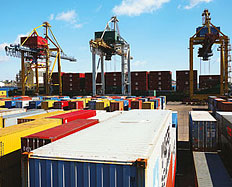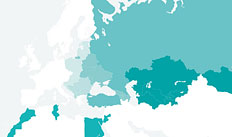COUNTRY ASSESSMENTS
Latvia
HIGHLIGHTS OF THE PAST YEAR
- The EU/IMF programme was successfully concluded at the end of 2011. This paves the way for compliance with key Maastricht criteria for public finances, and the government remains committed to euro adoption in 2014.
- The authorities have delivered a strong policy performance. As a result, Latvia has regained its investment grade sovereign credit rating and managed to return to international capital markets with substantial issues at manageable yields.
- The restructuring of the financial sector has progressed well. This applies particularly with regard to the successor institution to Parex, formerly the second largest bank in the country. The restructuring of Mortgage and Land Bank (MLB) is also under way.
KEY PRIORITIES FOR 2013
- The government should continue to pursue its competitiveness agenda. Skill mismatches are an increasingly prominent constraint on growth. Poor indicators for private research and development (R&D) and vocational training in comparison with European partners underline the need for improvements in these areas.
- The government should implement plans to improve the management and transparency of state-owned companies. Important proposals include moving to partially centralised ownership of state-owned enterprises, and regular publication of financial accounts.
- The gradual reinstatement of contributions to private pension funds should continue. The substantial assets accumulated in this process could begin to feed local needs for long-term funds, with prudent portfolio diversification remaining the key priority.
MACROECONOMIC PERFORMANCE
Latvia has seen a consistent recovery since early 2010, following a dramatic 20 per cent drop in GDP in 2008-09. The year 2011 saw one of the highest growth rates in the European Union (at 5.5 per cent) despite the implementation of further fiscal austerity measures. Exports remained on a steady expansion path in spite of the slow-down in the core eurozone economies in the second half of 2011, with capital and consumption goods performing particularly strongly. Industrial production weakened from the second half of last year, though still showed growth of about 7 per cent in annual terms in the first months of 2012. Despite this weakening in the external environment the economy showed one of the strongest quarterly growth rates of all EU countries in the second quarter, with a 1 per cent expansion compared with the previous quarter. Unemployment continues on a steady downward trend to currently almost 16 per cent.
Latvia concluded its three-year financial programme with the European Union and IMF in December 2011, and the balance-of-payments position (with a very small current account deficit in 2011) had adjusted to the point where the government did not need to draw on a substantial share of the available programme funds. The government remains, in principle, committed to eurozone accession in 2014, on which a decision will be taken by mid-2013. Euro membership could further reduce the cost of major refinancing needs in the coming years.
Further fiscal measures have already brought the fiscal deficit down to a much better than expected 3.5 per cent of GDP in 2011, and in the first half of 2012 the budget has similarly outperformed plans. External assessments by the European Commission (EC) and the IMF therefore expect that ambitious fiscal targets this year can be met. The target for inflation (which in July 2012 stood at only 1.7 per cent compared with a year ago) is similarly likely to be met, and reductions in indirect taxes have helped in this regard. The positive policy performance has been reflected in a number of sovereign rating upgrades, which paved the way for Latvia’s return to the capital markets in summer 2011 and again in February 2012. Overall credit to the private sector contracted by 8 per cent in 2011, though in the face of emerging capacity constraints corporate lending has expanded modestly. As in the other Baltic economies, foreign-owned bank subsidiaries continue to reduce their liabilities to their parents.
The short-term outlook is for a substantial weakening in growth as the eurozone stagnates. Continuing tight fiscal policy, wage adjustments in the face of still considerable unemployment and the contraction in credit remain key impediments to Latvia’s growth in the next two years. There is also an ongoing risk to bank asset quality, with the share of non-performing loans still remaining at around 12.5 per cent.
MAJOR STRUCTURAL REFORM DEVELOPMENTS
The government has focused on strengthening competitiveness and the investment regime. An action plan of 645 measures in such areas as human capital, innovation and investment promotion was adopted by parliament in February 2012. Strengthening education is a key priority; for instance, enrolment in vocational education in Latvia remains one of the lowest in the European Union. The action plan comprises measures on higher education, where infrastructure and equipment are to be modernised, and legislative changes aimed at enhancing flexibility and focusing on study fields more in line with demand expressed by industry. Private R&D spending remains the lowest in the European Union, though the government is seeking to take steps to accelerate the commercialisation of scientific research, for example, by establishing competence centres and stimulating knowledge transfer.
Latvia remains an attractive location for foreign direct investment. Inflows accounted for about 5 per cent of GDP in 2011, in line with the other Baltic economies. A recent initiative by the president is to give greater autonomy to regional governments in giving incentives for investment in production facilities. The government remains committed to strengthening attractiveness to FDI investors in priority sectors, such as export-oriented manufacturing or energy efficiency investments.
The governance and anti-competitive conduct of state-owned companies remains a concern for private investors, though the government is pursuing measures to address these issues. The government’s intention is to partially centralise ownership of state-owned enterprises, and to enhance transparency through regular publication of financial accounts. The decision by Latvenergo to have its long-term bonds quoted on the local exchange and to comply with the resulting listing requirements is a step in this direction. The nationalisation of the remaining shares in the state airline, Air Baltic, became necessary following the failure of Lithuanian Bank Snoras, and of its Latvian subsidiary. However, the airline remains loss-making and required a substantial cash injection by the government in October 2011. This may give rise to a state-aid investigation by the EC.
Integration in the regional energy markets remains a priority. In August 2012 the government announced measures that mandate large enterprises to contract their electricity in the open market (as opposed to transacting at regulated prices). This is expected to enhance competition, ultimately also benefiting households. The planned nuclear power plant and LNG terminal in Lithuania could also help to reduce energy costs in Latvia.
The financial sector continues to return to health. The liquidation in November 2011 of Krajbanka, the subsidiary of Lithuanian Bank Snoras, was due to an isolated case of fraud at the parent bank. The supervisor has since confirmed through more in-depth on-site inspections that no similar problems exist in other banks. This bank failure did, however, highlight some remaining inefficiencies in the coordination of supervisory intervention with other countries in the region, even though this coordination is in principle very close, given the contacts built up through the Nordic-Baltic Memorandum of Understanding (MoU). Elsewhere, Citadele Bank, the “good bank” successor to Parex Bank following its nationalisation in late 2008, is continuing its restructuring programme, including through the sale of various foreign participations in agreement with the competition directorate of the EC. This should facilitate the ultimate objective of transferring the bank back into private ownership and reviving growth in credit in the domestic credit market. The remaining institution – also named Parex Bank – that took over delinquent assets ceased commercial banking operations in March 2012. Renamed Reverta, it continues to manage delinquent assets with a view to maximising recoveries. The sale of Mortgage and Land Bank (MLB), Latvia’s eighth largest bank and the remaining state participation in the sector, is progressing and, according to the government, should be concluded by the end of 2012.
The government is committed to gradually reinstating contributions to private pension funds. During the severe 2009 recession, Latvia reduced contributions to mandatory (second pillar) pension funds from 8 to 2 per cent of gross salaries, similar to measures also adopted by several other countries in central Europe and the Baltics.
In July 2012 the government approved a gradual increase of contributions from 2013 to ultimately 6 per cent in 2016, underlining a commitment to the three-pillar model. These funds, which currently hold assets of about €1.5 billion, could be an important source of local long-term capital, which is increasingly sought by large domestic enterprises. The decision to gradually increase the retirement age to 65 years, from the current 62 years, along with several other changes in entitlements, should also help to put the finances of the state system on a more sustainable footing.







